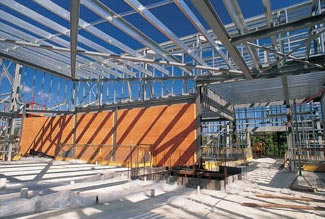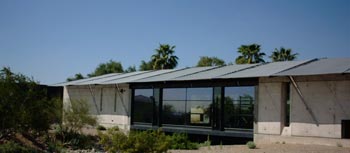For an increasing number of determined people, the Australian dream is not just owning your own home. It is building it. This seems especially true in Victoria, where one in five of the $7.9 billion worth of domestic building jobs is done by ownerbuilders. Many, such as Melbourne journalist, Murray Johnson, do not have any building experience, but manage to erect impressive homes. Johnson, 45, began his mud brick house when spiralling Melbourne house prices ruled him out of the market at the end of the 1990’s.
National Wine Centre of Austrailia

The National Wine Centre of Australia, located in Adelaide, South Austrailia, was designed by Grieve Gillette and Cox Architects. According to the builder, Mitchell Builders, it contains the largest rammed earth wall in Austrailia. Soil taken from all leading wine districts was used in the construction of the wall, which makes up the center spine of the building. The architecture emerges from this spine much like a grape vine from the soil. More construction photos of the Centre are available at the National Wine Centre website and more info and photos can be found at www.archidose.org
Call for Papers: LEHM 2004 Conference on Building with Earth
The LEHM 2004 is the 4th international conference and trade fair for building with earth and will be held at the famous Leipziger Messe in Leipzig, Germany, October 27-30th, 2004. The conference will coincide with the denkmal 2004, one of the largest trade fairs worldwide for reconstruction and conservation. The previous denkmal 2002 attracted more than 18,000 visitors from 35 countries with more than 400 exhibitors from 15 countries.
In Germany as in many other parts of the world, earth is used as a building material in conservation work. The LEHM 2004 conference will focus on “Earth in Building Conservation”. The Dachverband Lehm e.V. extends an open invitation to all interested professional colleagues to submit thematic relevant contributions and papers for the LEHM 2004 conference as well as for a poster session which will be exhibited parallel to the conference. The theme of the conference programme will include the following subject areas:
– Earthen building: a thousand years of building culture
– UNESCO world heritage – building with earth
– New earthen building technology in conservation practice
– New projects forum (as a permanent conference feature)
Candidates wishing to present a paper or poster at the conference are requested to submit a short overview (abstract) of not more than 500 words. Submissions can be in German or English. More details, submission information and deadlines are available from: www.dachverband-lehm.de/lehm2004
Butabu

Butabu: Adobe Architecture of West Africa by architectural photographer James Morris and Professor of African Art and Architecture at Harvard University, Suzanne Preston Blier, shows the sublime sculptural beauty, variety, ingenuity, and originality of Sahalian Architecture in the West African countries of Mali, Niger, Nigeria, Togo, Benin, Ghana, and Burkina Faso where people have been constructing earthen buildings for centuries.
House of Earth and Light

The House of Earth and Light, a private residence designed by Iraq-born, Phoenix Architect Marwan Al-Sayed uses a 3-layer fabric roof to bring tension and lightness to the thick poured gypsum walls. Computer renderings of the building show the proposed quality of the architecture. More information can be found here in an article by the Industrial Fabrics Association International (.pdf format).
Earth Homes Handbook
The Handbook for Building Homes of Earth, published by the Peace Corps Information and Collection Exchange, is available on-line with chapters discussing adobe, rammed earth, compressed earth and other relevant technologies and methods.
How to Build a Rammed Earth House
From Issue # 23 – September/October 1973 of the Mother Earth News, “How to Build a Rammed Earth House” written by John O. McMeekin: “Back in the 40’s I was considered an oddball. I wore a beard — revolutionary then — and I started, by myself, to build a house out of (of all things) rammed earth. People wondered about me. Today — as a V.P. and corporation director — I appear Establishment, and my home doesn’t look unusual either. It hugs a hilltop landscape, it’s surrounded by spacious lawns and sheltered by big oaks … and in the garage are two (count them, two) Mercedes. But my house is still made of rammed earth.
Dachverband Lehm
Dachverband Lehm is a German organization interested in promoting the culture of building with earth. The association sees itself as an umbrella organization for all those interested in earth and earthen building. The organization coordinates and concentrates the various activities of its members. Dachverband Lehm was established in 1992 as an association to promote the culture of building with earth and to represent all those interested or working in the field. Today they are the internationally recognised representative in Germany for clay and earth building. Their work in establishing technical building regulations, the “Lehmbau Regeln”, and their vocational training programme “Specialist for Building with Earth”, recognized by the Chamber of Trade and Commerce, are exemplary in Germany.
Their website offers a series of interesting links regarding international earth building.
Adobe Architecture
The North Texas Institute for Educators on the Visual Arts offers a concise history and explaination of adobe architecture.
David Easton
The Rammed Earth House written by David Easton, describes the beauty and grace of rammed earth construction. The photographs of different structures, both modern and ancient, by Cynthia Wright, create a breathtaking glimpse into a building technique that is as old as human history, but exactly suitable for today’s resource-conscious and environmentally friendly building needs. Rammed Earth Works, established in 1978, has distinguished itself as one of the world’s leading company in the research and development of modern earth construction technologies. Founder David Easton is the internationally recognized developer of PISE, Terratile, the Easton forming system for rammed earth and cast elements, and construction systems for engineered earth walls which are code compliant and compatible with current building trades.
